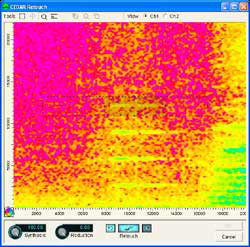The invention of spectral editing: CEDAR Retouch™

1 February 2002
In photography, "retouching" is the art of identifying and removing unwanted blemishes from a picture to produce a perfect image. CEDAR Retouch™ brings this concept into the audio world, allowing you to remove unwanted acoustic events from a signal.
Until now, audio restoration systems have been limited as to the types of discrete noises that they can remove: clicks and scratches, crackle and buzz, pops and thumps. But today, CEDAR Retouch offers a huge leap forward in processing technology, allowing you to identify and eliminate sounds as varied as coughs, record scuffs, squeaky chairs, page turns, the creak of a piano pedal and even a car horn.
There are no conventional methods available for removing these types of noise. Nonetheless, some engineers have attempted to use techniques such as severe EQ which, in addition to being completely inappropriate to such short duration problems, introduces ringing. Retouch does not suffer from this type of side-effect. Others have used (and misused) harsh compression, tight editing, and signal interpolators that affect the whole frequency spectrum. These damage good signal that should be left untouched, and can introduce unwanted side-effects such as high frequency drop-outs. In contrast, CEDAR's 64-bit, 96kHz Retouch process operates on both the temporal and spectral content of a signal, offering graphical tools that can localise unwanted sounds accurately in both time and frequency. Once identified, those sounds - which can be tonal or resemble broadband noise - are replaced with audio derived from the surrounding signal. All other audio remains untouched.
Audio Engineer Tony Webster has been using development versions of Retouch at CEDAR's in-house studio, Cambridge Sound Restoration. He says of it, "Retouch is a revolutionary product, something to pull out when everything else fails. If you're serious about sound restoration, you're going to need this. I've been testing various incarnations of Retouch since July 2001, and I have used it on a range of projects such as classical recordings for CDs, and numerous post-production jobs. In fact, we've already received a credit on BBC TV for using Retouch to remove 'splodges' from the soundtrack of a Marilyn Monroe documentary that was broadcast on BBC2 on 28 December, last year."
When all else fails... Retouch gives you complete control.
Patent applied for. Retouch is a trademark of CEDAR Audio Limited.
For further information:
CEDAR Audio Limited, 20 Home End, Fulbourn, Cambridge, CB21 5BS, United Kingdom.
t: +44 1223 881771
f: +44 1223 881778
e: info@cedaraudio.com